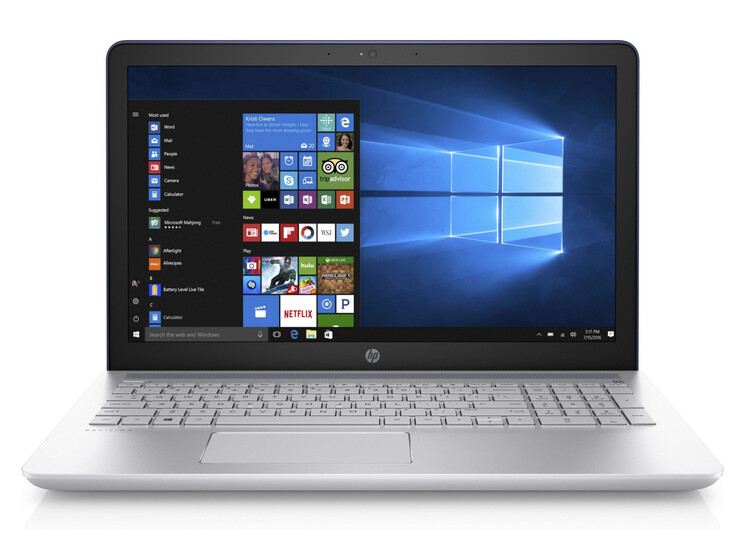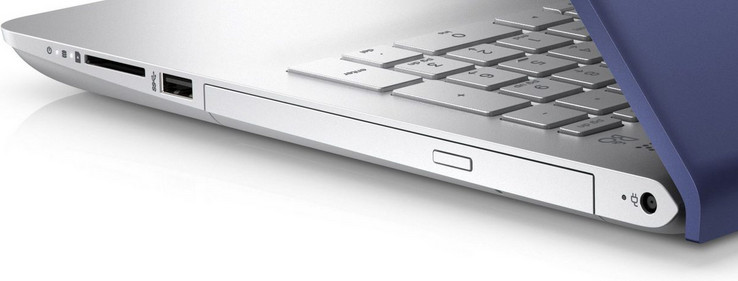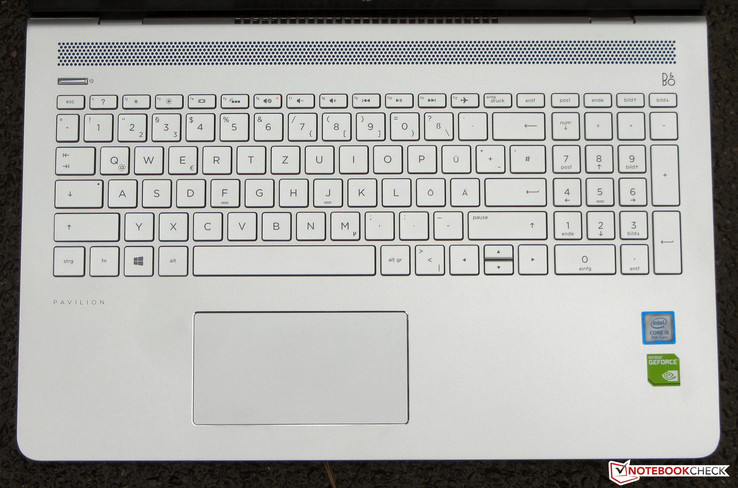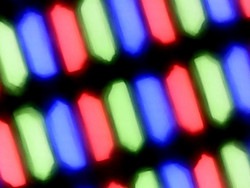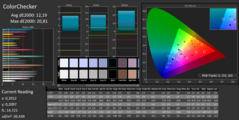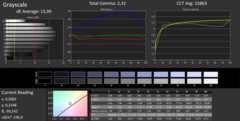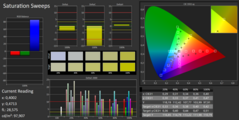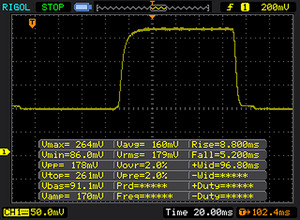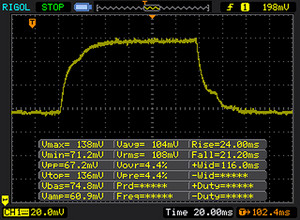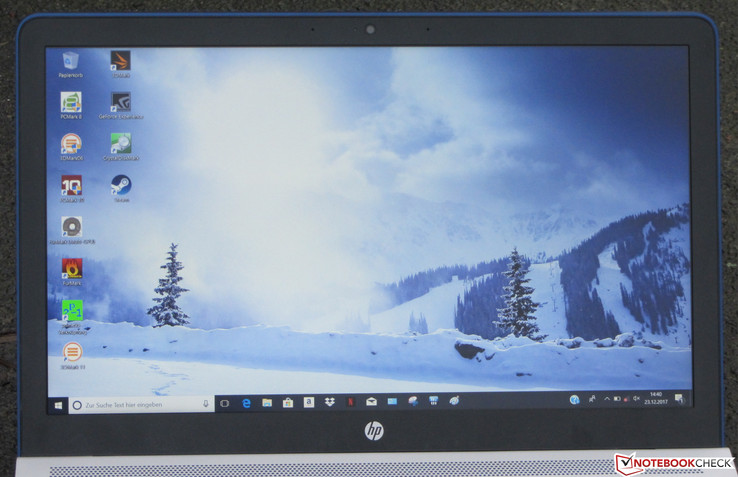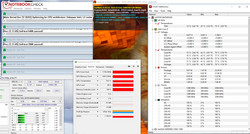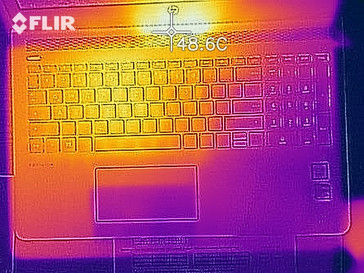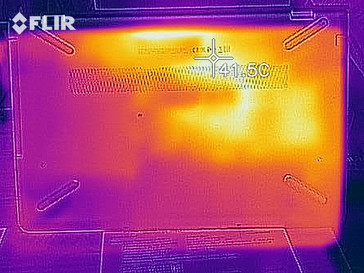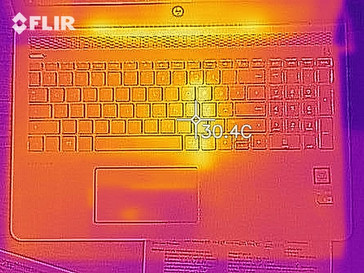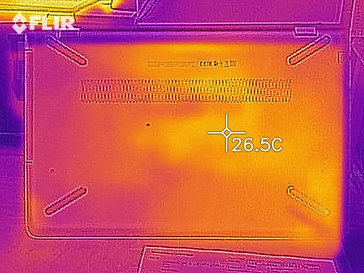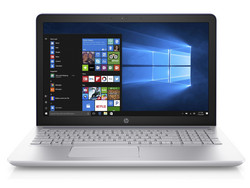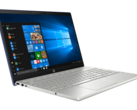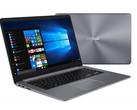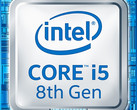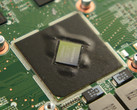HP Pavilion 15t (i5-8250U, 940MX, FHD) Laptop Review

Hewlett Packard's 15.6-inch Pavilion 15-cc107 all-rounder is driven by a ULV quad-core processor of the Kaby Lake generation. The dedicated GeForce graphics core enables playing computer games, at least to a limited extent. The competitors of the notebook include devices such as the HP 15-bs103ng, the Acer Swift 3 SF315-51G-57E5, and the Lenovo IdeaPad 320-15IKB.
Case and Connectivity
In the Pavilion 15, HP uses a mix of plastic and metal. Only the top of the base is made from the latter, and the entire base unit is in silver color. The display bezel is made of black plastic, and the back of the lid is covered in blue. We like the workmanship of the device: the gaps are even, and we did not notice any protrusions. It is just the way it should be. In terms of stability, things are not looking quite as good, and the base unit could have been more rigid. The battery is built in.
Since the notebook has no maintenance flap, the device has to be opened for an upgrade or maintenance. To do that, you need to first take out the optical drive. Then you have to remove the screws at the bottom of the device. In addition to the visible screws, there are also screws hidden under the four rubber feet. After removing all the screws, the bottom has to be taken off with the help of a flat tool. You then have access to the memory banks, the fan, the SSD, the battery, and the WLAN module.
In terms of the connections, the Pavilion does not offer any surprises. HP has equipped the computer with three USB-3.1 Gen-1 connections (2x Type-A, 1x Type-C). These are accompanied by one HDMI port and one Gigabit Ethernet connection. The built-in storage card reader operates fast. It achieves a maximum transfer rate of 86.9 MB/s when copying large data blocks and transfers 250 JPG image files (about 5 MB each) at a speed of 80.2 MB/s, leaving the competition clearly behind. We test storage card readers by using a reference card (Toshiba Exceria Pro SDXC 64 GB UHS-II).
The WLAN module uses an Intel chip (Dual Band Wireless-AC 7265). In addition to the 802.11a/b/g/h/n WLAN standards, it also supports the fast ac standard. The transfer speeds we measured under optimal conditions (no other WLAN devices in close proximity, close distance between notebook and server PC) turned out to be good.
Connections
| SD Card Reader | |
| average JPG Copy Test (av. of 3 runs) | |
| HP Pavilion 15-cc107ng (Toshiba Exceria Pro SDXC 64 GB UHS-II) | |
| Lenovo IdeaPad 320-15IKB 80XL01NEGE (Toshiba Exceria Pro SDXC 64 GB UHS-II) | |
| HP 15-bs103ng (Toshiba Exceria Pro SDXC 64 GB UHS-II) | |
| Acer Swift 3 SF315-51G-57E5 (Toshiba Exceria Pro SDXC 64 GB UHS-II) | |
| maximum AS SSD Seq Read Test (1GB) | |
| HP Pavilion 15-cc107ng (Toshiba Exceria Pro SDXC 64 GB UHS-II) | |
| Lenovo IdeaPad 320-15IKB 80XL01NEGE (Toshiba Exceria Pro SDXC 64 GB UHS-II) | |
| HP 15-bs103ng (Toshiba Exceria Pro SDXC 64 GB UHS-II) | |
| Acer Swift 3 SF315-51G-57E5 (Toshiba Exceria Pro SDXC 64 GB UHS-II) | |
| Networking | |
| iperf3 transmit AX12 | |
| HP Pavilion 15-cc107ng | |
| Acer Swift 3 SF315-51G-57E5 | |
| HP 15-bs103ng | |
| Lenovo IdeaPad 320-15IKB 80XL01NEGE | |
| iperf3 receive AX12 | |
| HP Pavilion 15-cc107ng | |
| Acer Swift 3 SF315-51G-57E5 | |
| HP 15-bs103ng | |
| Lenovo IdeaPad 320-15IKB 80XL01NEGE | |
Input Devices
HP has equipped the notebook with a backlit chiclet keyboard. The illumination is controlled by a function key. There is only one brightness level. The smooth keys have a short stroke and a clear pressure point. While typing, the keyboard flexes marginally at most, which was not annoying. Overall, HP has delivered a decent keyboard, which is also suited for regular typing tasks.
The multitouch-capable ClickPad has a footprint of about 11.5 x 6 cm (4.5 x 2.4 in). This offers a lot of space for gesture controls. You can turn on or off the various gestures individually in the configuration menu of the pad. The smooth pad surface makes sliding easy. It has a short stroke and a clear pressure point.
Display
The matte 15.6-inch display of the Pavilion has a native resolution of 1920x1080 pixels. Considering the price point of 800 Euros (~$960), the brightness (230.1 cd/m2) and contrast (688:1) are too low. We are expecting values beyond 300 cd/m2 and 1000:1 here. On the positive side, the display does not produce any PWM flickering at any time.
| |||||||||||||||||||||||||
Brightness Distribution: 76 %
Center on Battery: 200 cd/m²
Contrast: 688:1 (Black: 0.34 cd/m²)
ΔE ColorChecker Calman: 12.19 | ∀{0.5-29.43 Ø4.79}
ΔE Greyscale Calman: 13.99 | ∀{0.09-98 Ø5}
56% sRGB (Argyll 1.6.3 3D)
36% AdobeRGB 1998 (Argyll 1.6.3 3D)
38.51% AdobeRGB 1998 (Argyll 3D)
56.1% sRGB (Argyll 3D)
37.28% Display P3 (Argyll 3D)
Gamma: 2.32
CCT: 15863 K
| HP Pavilion 15-cc107ng TN LED, 1920x1080, 15.6" | Lenovo IdeaPad 320-15IKB 80XL01NEGE TN LED, 1920x1080, 15.6" | Acer Swift 3 SF315-51G-57E5 IPS, 1920x1080, 15.6" | HP 15-bs103ng TN LED, 1920x1080, 15.6" | |
|---|---|---|---|---|
| Screen | -3% | 32% | -7% | |
| Brightness middle (cd/m²) | 234 | 227 -3% | 248 6% | 241 3% |
| Brightness (cd/m²) | 230 | 207 -10% | 237 3% | 235 2% |
| Brightness Distribution (%) | 76 | 81 7% | 79 4% | 84 11% |
| Black Level * (cd/m²) | 0.34 | 0.44 -29% | 0.21 38% | 0.43 -26% |
| Contrast (:1) | 688 | 516 -25% | 1181 72% | 560 -19% |
| Colorchecker dE 2000 * | 12.19 | 11.52 5% | 4.98 59% | 13.62 -12% |
| Colorchecker dE 2000 max. * | 20.81 | 19.97 4% | 8.41 60% | 22.81 -10% |
| Greyscale dE 2000 * | 13.99 | 12.01 14% | 4.26 70% | 15.19 -9% |
| Gamma | 2.32 95% | 2.23 99% | 2.37 93% | 2.13 103% |
| CCT | 15863 41% | 13330 49% | 7149 91% | 17407 37% |
| Color Space (Percent of AdobeRGB 1998) (%) | 36 | 38 6% | 38 6% | 35 -3% |
| Color Space (Percent of sRGB) (%) | 56 | 59 5% | 58 4% | 55 -2% |
* ... smaller is better
Screen Flickering / PWM (Pulse-Width Modulation)
| Screen flickering / PWM not detected | ||
In comparison: 53 % of all tested devices do not use PWM to dim the display. If PWM was detected, an average of 8156 (minimum: 5 - maximum: 343500) Hz was measured. | ||
Display Response Times
| ↔ Response Time Black to White | ||
|---|---|---|
| 13 ms ... rise ↗ and fall ↘ combined | ↗ 8 ms rise | |
| ↘ 5 ms fall | ||
| The screen shows good response rates in our tests, but may be too slow for competitive gamers. In comparison, all tested devices range from 0.1 (minimum) to 240 (maximum) ms. » 32 % of all devices are better. This means that the measured response time is better than the average of all tested devices (20.3 ms). | ||
| ↔ Response Time 50% Grey to 80% Grey | ||
| 45 ms ... rise ↗ and fall ↘ combined | ↗ 24 ms rise | |
| ↘ 21 ms fall | ||
| The screen shows slow response rates in our tests and will be unsatisfactory for gamers. In comparison, all tested devices range from 0.165 (minimum) to 636 (maximum) ms. » 76 % of all devices are better. This means that the measured response time is worse than the average of all tested devices (31.7 ms). | ||
HP has equipped the computer with a TN panel with unstable viewing angles, and you cannot read the display from all positions. Outdoors, the notebook can only be used when the sun is not shining. In battery mode, the maximum brightness is lowered to 200 cd/m2.
Performance
With the Pavilion 15, HP delivers an all-rounder in the 15.6-inch format. The notebook offers enough performance for all the usual applications. Our test unit can be purchased for about 900 Euros (~$1080; a similar model with an i7-8550U costs $839 in the US). Other model variants are also available.
Processor
Inside the Pavilion is an Intel Core i5-8250U (Kaby Lake Refresh) quad-core processor. This is an energy efficient ULV model (TDP: 15 watts) which supports Hyper-threading (running two threads per core). The processor operates at a basic speed of 1.6 GHz, which can be increased via Turbo up to 3.4 GHz.
In the multithread tests of the Cinebench benchmarks, the CPU runs at 3.4 GHz for only a few seconds, and then it is throttled to 2.4 to 2.5 GHz. In the single-thread tests of the Cinebench benchmarks, this throttling does not occur, and they run at full Turbo speed. The same goes also for the Geekbench benchmarks. The behavior is identical in mains and battery operation.
We are testing whether the Turbo is also used for long periods of time by running the multithread test of Cinebench R15 for about 30 minutes in a constant loop. After the first run, the results drop to about 515 to 520 points and remain at that level. Thus, a Turbo speed of 2.4 to 2.5 GHz can also be maintained constantly.
The results of the CPU tests we ran are at the normal level for the built-in processor. In the Geekbench benchmarks, the Pavilion fares slightly worse than the Acer Swift 3 SF315-51G-57E5 which is equipped with the same CPU, since the working memory of the HP notebook only operates in single-channel mode (Swift 3: dual-channel mode).
| Cinebench R15 | |
| CPU Single 64Bit | |
| HP Pavilion 15-cc107ng | |
| Acer Swift 3 SF315-51G-57E5 | |
| Dell Vostro 15 5568 | |
| HP 15-bs103ng | |
| Lenovo IdeaPad 320-15IKB 80XL01NEGE | |
| CPU Multi 64Bit | |
| Acer Swift 3 SF315-51G-57E5 | |
| HP Pavilion 15-cc107ng | |
| HP 15-bs103ng | |
| Lenovo IdeaPad 320-15IKB 80XL01NEGE | |
| Dell Vostro 15 5568 | |
| Cinebench R10 | |
| Rendering Single 32Bit | |
| HP Pavilion 15-cc107ng | |
| Acer Swift 3 SF315-51G-57E5 | |
| HP 15-bs103ng | |
| Lenovo IdeaPad 320-15IKB 80XL01NEGE | |
| Rendering Multiple CPUs 32Bit | |
| HP 15-bs103ng | |
| Acer Swift 3 SF315-51G-57E5 | |
| HP Pavilion 15-cc107ng | |
| Lenovo IdeaPad 320-15IKB 80XL01NEGE | |
| Geekbench 3 | |
| 32 Bit Multi-Core Score | |
| Acer Swift 3 SF315-51G-57E5 | |
| HP 15-bs103ng | |
| HP Pavilion 15-cc107ng | |
| Lenovo IdeaPad 320-15IKB 80XL01NEGE | |
| 32 Bit Single-Core Score | |
| Acer Swift 3 SF315-51G-57E5 | |
| HP Pavilion 15-cc107ng | |
| HP 15-bs103ng | |
| Lenovo IdeaPad 320-15IKB 80XL01NEGE | |
| Geekbench 4.0 | |
| 64 Bit Multi-Core Score | |
| Acer Swift 3 SF315-51G-57E5 | |
| HP Pavilion 15-cc107ng | |
| HP 15-bs103ng | |
| Lenovo IdeaPad 320-15IKB 80XL01NEGE | |
| 64 Bit Single-Core Score | |
| Acer Swift 3 SF315-51G-57E5 | |
| HP Pavilion 15-cc107ng | |
| HP 15-bs103ng | |
| Lenovo IdeaPad 320-15IKB 80XL01NEGE | |
| Geekbench 4.4 | |
| 64 Bit Multi-Core Score | |
| Acer Swift 3 SF315-51G-57E5 | |
| HP Pavilion 15-cc107ng | |
| HP 15-bs103ng | |
| Lenovo IdeaPad 320-15IKB 80XL01NEGE | |
| 64 Bit Single-Core Score | |
| Acer Swift 3 SF315-51G-57E5 | |
| HP Pavilion 15-cc107ng | |
| HP 15-bs103ng | |
| Lenovo IdeaPad 320-15IKB 80XL01NEGE | |
| JetStream 1.1 - Total Score | |
| HP Pavilion 15-cc107ng (Edge 41) | |
| HP 15-bs103ng (Edge 41) | |
| Acer Swift 3 SF315-51G-57E5 (Edge 40) | |
| Lenovo IdeaPad 320-15IKB 80XL01NEGE (Edge 40) | |
System Performance
A fast solid-state disk and a powerful processor ensure a smooth running system. We did not encounter any problems. The very good results in the PC Mark benchmarks attest that the notebook has more than enough computing power for office and internet applications. The dedicated graphics core enables at least limited use of computer games. A slight increase of the overall performance should be possible, if the notebook were equipped with a second module of working memory to activate the dual-channel mode.
| PCMark 8 Home Score Accelerated v2 | 3683 points | |
| PCMark 8 Creative Score Accelerated v2 | 4825 points | |
| PCMark 8 Work Score Accelerated v2 | 4812 points | |
| PCMark 10 Score | 3505 points | |
Help | ||
| PCMark 8 - Home Score Accelerated v2 | |
| Acer Swift 3 SF315-51G-57E5 | |
| HP Pavilion 15-cc107ng | |
| Lenovo IdeaPad 320-15IKB 80XL01NEGE | |
| HP 15-bs103ng | |
Storage Solution
A SATA-III SSD by SanDisk serves as the system drive. This is a model in the M.2-2280 format, which has a total capacity of 256 GB. Of this, about 190 GB is still usable in the state of delivery, and the remaining storage is distributed among the Windows installation and the recovery partition. The transfer rates are good.
The maintenance manual of the notebook tells us that the Pavilion-15 models with model numbers 15-cc1xx or 15-cc6xx can also accept NVMe-SSDs. Our test unit is one of these models. NVMe SSDs offer significantly higher transfer rates than SATA-III SSDs.
In addition to the M.2-2280 SSD, the Pavilion can also host a 2.5-inch hard drive. However, our test unit neither includes the necessary frame to insert this, nor the data cable. If required, you have to purchase them separately.
| HP Pavilion 15-cc107ng GeForce 940MX, i5-8250U, SanDisk SD8SN8U256G1006 | Dell Vostro 15 5568 GeForce 940MX, i7-7500U, Transcend MTS400 256 GB M.2 TS256GMTS400 | Lenovo IdeaPad 320-15IKB 80XL01NEGE GeForce 940MX, i5-7200U, SK Hynix HFS256G3BTND | Acer Swift 3 SF315-51G-57E5 GeForce MX150, i5-8250U, Hynix HFS128G39TND | HP 15-bs103ng Radeon 520, i5-8250U, Samsung SSD PM871a MZNLN256HMHQ | |
|---|---|---|---|---|---|
| CrystalDiskMark 3.0 | -7% | 9% | -7% | 31% | |
| Read Seq (MB/s) | 475.4 | 535 13% | 466.4 -2% | 481.5 1% | 504 6% |
| Write Seq (MB/s) | 453.5 | 391.1 -14% | 259.3 -43% | 131.5 -71% | 466.2 3% |
| Read 512 (MB/s) | 345.2 | 376.6 9% | 314.5 -9% | 324.8 -6% | 443.7 29% |
| Write 512 (MB/s) | 299.1 | 255.8 -14% | 259.4 -13% | 130.6 -56% | 398.4 33% |
| Read 4k (MB/s) | 27.8 | 31.81 14% | 31.47 13% | 30.81 11% | 38.81 40% |
| Write 4k (MB/s) | 54.2 | 65.2 20% | 78.3 44% | 84.8 56% | 94.6 75% |
| Read 4k QD32 (MB/s) | 250.9 | 193.9 -23% | 346.1 38% | 345 38% | 295.2 18% |
| Write 4k QD32 (MB/s) | 181.8 | 73.1 -60% | 260.4 43% | 131.6 -28% | 266.6 47% |
Graphics Card
HP has equipped the Pavilion 15 with a dedicated graphics core. The built-in GeForce 940MXGPU is considered an entry-range model. It supports DirectX 12 and operates at speeds up to 1176 MHz. The graphics core can access 2048 MB of DDR3 storage. The results in the 3D Mark benchmark are at a normal level for the GPU used here. The Lenovo IdeaPad 320-15IKB which is equipped with the same GPU fares better than the Pavilion, since it is equipped with the fast GDDR5 graphics storage.
| 3DMark 11 Performance | 2647 points | |
| 3DMark Cloud Gate Standard Score | 8384 points | |
| 3DMark Fire Strike Score | 1539 points | |
Help | ||
| 3DMark 11 - 1280x720 Performance GPU | |
| Acer Swift 3 SF315-51G-57E5 | |
| Lenovo IdeaPad 320-15IKB 80XL01NEGE | |
| Dell Vostro 15 5568 | |
| HP Pavilion 15-cc107ng | |
| HP 15-bs103ng | |
Gaming Performance
The built-in hardware brings many computer games smoothly to the matte display. In most cases you have to limit yourself to the HD resolution (1366x768 pixels) and low to medium quality settings, in order to generate frame rates that are sufficiently high. Games that only make few demands on the hardware allow for more. However, with many games of the year 2017, things get tight and the GPU performance is not sufficient. Games such as "Assassin's Creed Origins" and "Destiny 2" require a more powerful GPU.
| low | med. | high | ultra | |
|---|---|---|---|---|
| BioShock Infinite (2013) | 89.2 | 51.7 | 41.9 | 14.5 |
| Star Wars Battlefront 2 (2017) | 44.8 | 13.6 | 10.8 | 9.5 |
| BioShock Infinite - 1366x768 High Preset | |
| Acer Swift 3 SF315-51G-57E5 | |
| Lenovo IdeaPad 320-15IKB 80XL01NEGE | |
| Dell Vostro 15 5568 | |
| HP Pavilion 15-cc107ng | |
| HP 15-bs103ng | |
Emissions and Power Management
Noise Emissions
While idling, the fan of the Pavilion is running constantly. However, it is so quiet that it is hardly audible. The activated "Fan always on" BIOS option is responsible for this in this HP notebook. If it is deactivated, the fan often does not run during idle. Under load, the fan revs up. However, the noise level under full load (stress test) is slightly lower than under medium load. The reason for this is that the CPU is heavily throttled during the stress test.
Noise level
| Idle |
| 30.9 / 30.9 / 31 dB(A) |
| Load |
| 37.2 / 36.8 dB(A) |
 | ||
30 dB silent 40 dB(A) audible 50 dB(A) loud |
||
min: | ||
Temperature
The Pavilion runs through our stress test (Prime95 and FurMark run for at least one hour) in slightly different ways in mains and battery operation. While the graphics core always operates at full speed (1176 MHz), the speed of the CPU jumps between 400 MHz and 1.6 GHz in battery operation. In mains operation, it runs briefly at high speed and then it is throttled to between 1.3 and 1.5 GHz.
The notebook does not get particularly warm. During the stress test, it barely exceeds the 40-degree Celsius mark (104 °F) at two measurement points.
(±) The maximum temperature on the upper side is 42.3 °C / 108 F, compared to the average of 36.9 °C / 98 F, ranging from 21.1 to 71 °C for the class Multimedia.
(±) The bottom heats up to a maximum of 40 °C / 104 F, compared to the average of 39.2 °C / 103 F
(+) In idle usage, the average temperature for the upper side is 23.7 °C / 75 F, compared to the device average of 31.3 °C / 88 F.
(+) The palmrests and touchpad are cooler than skin temperature with a maximum of 28.5 °C / 83.3 F and are therefore cool to the touch.
(±) The average temperature of the palmrest area of similar devices was 28.7 °C / 83.7 F (+0.2 °C / 0.4 F).
Speakers
The stereo speakers are located above the keyboard behind a perforated cover. They produce a quite decent sound which is lacking bass to a large extent. For a better sound experience, we recommend using headphones or external speakers.
HP Pavilion 15-cc107ng audio analysis
(-) | not very loud speakers (70.9 dB)
Bass 100 - 315 Hz
(-) | nearly no bass - on average 29.1% lower than median
(±) | linearity of bass is average (10.9% delta to prev. frequency)
Mids 400 - 2000 Hz
(+) | balanced mids - only 2.2% away from median
(±) | linearity of mids is average (7.9% delta to prev. frequency)
Highs 2 - 16 kHz
(+) | balanced highs - only 2.3% away from median
(+) | highs are linear (4.4% delta to prev. frequency)
Overall 100 - 16.000 Hz
(±) | linearity of overall sound is average (21.3% difference to median)
Compared to same class
» 73% of all tested devices in this class were better, 6% similar, 21% worse
» The best had a delta of 5%, average was 17%, worst was 45%
Compared to all devices tested
» 58% of all tested devices were better, 7% similar, 35% worse
» The best had a delta of 4%, average was 24%, worst was 134%
Apple MacBook 12 (Early 2016) 1.1 GHz audio analysis
(+) | speakers can play relatively loud (83.6 dB)
Bass 100 - 315 Hz
(±) | reduced bass - on average 11.3% lower than median
(±) | linearity of bass is average (14.2% delta to prev. frequency)
Mids 400 - 2000 Hz
(+) | balanced mids - only 2.4% away from median
(+) | mids are linear (5.5% delta to prev. frequency)
Highs 2 - 16 kHz
(+) | balanced highs - only 2% away from median
(+) | highs are linear (4.5% delta to prev. frequency)
Overall 100 - 16.000 Hz
(+) | overall sound is linear (10.2% difference to median)
Compared to same class
» 7% of all tested devices in this class were better, 2% similar, 91% worse
» The best had a delta of 5%, average was 18%, worst was 53%
Compared to all devices tested
» 4% of all tested devices were better, 1% similar, 94% worse
» The best had a delta of 4%, average was 24%, worst was 134%
Frequency comparison (Checkboxes selectable!)
Power Consumption
While idling, we measured a maximum power consumption of 7.5 watts, which is a good value. In the beginning of the stress test (Prime95 and FurMark are running for at least one hour), the value increases to 56 watts and then drops to 47 watts after a short time, since the CPU is throttled. With only Prime95 running, the power consumption is higher at 61 watts. The power supply is rated at 90 watts.
| Off / Standby | |
| Idle | |
| Load |
|
Key:
min: | |
Battery Life
Our practically relevant WLAN test simulates the load when calling up websites via a script. The "Balanced" power profile is active, the display brightness is set to about 150 cd/m², and the power saving functions are deactivated. The Pavilion achieves a runtime of 6:35 hours.
| Battery Runtime - WiFi Websurfing | |
| Acer Swift 3 SF315-51G-57E5 (Edge 40) | |
| HP 15-bs103ng (Edge 41) | |
| HP Pavilion 15-cc107ng (Edge 41) | |
| Lenovo IdeaPad 320-15IKB 80XL01NEGE (Edge 40) | |
Pros
Cons
Verdict
With the Pavilion 15-cc107ng, HP has a 15.6-inch all-rounder in its offerings. The built-in ULV quad-core processor offers more than enough computing power for all the usual application scenarios. The dedicated graphics core enables the limited use of many computer games. However, it gets tight for the most current games, and for that scenario, HP should have used a more powerful graphics core such as the GeForce MX150 GPU.
With the Pavilion 15-cc107ng, HP offers a solid all-rounder for the home, which would have deserved a better display.
The notebook warms up only moderately and usually runs quietly. A fast solid-state disk ensures a fast running system. The keyboard left a decent impression and is also suitable for frequent typing work. The presence of a keyboard backlight is a positive. This is accompanied by a good battery life.
The display will not earn any awards. HP uses a dark and low-contrast model with unstable viewing angles. The price level requires more than that, and a bright, high-contrast IPS display should be a given. We also do not like the one-year-only warranty, and it should have been two years.
HP Pavilion 15-cc107ng
- 01/01/2018 v6 (old)
Sascha Mölck




